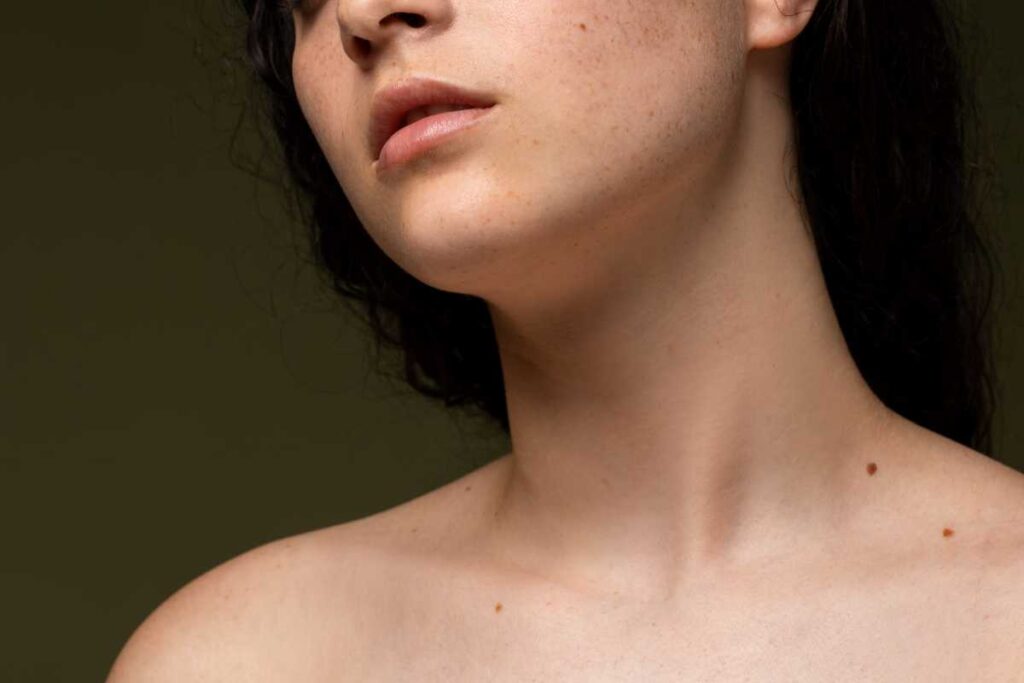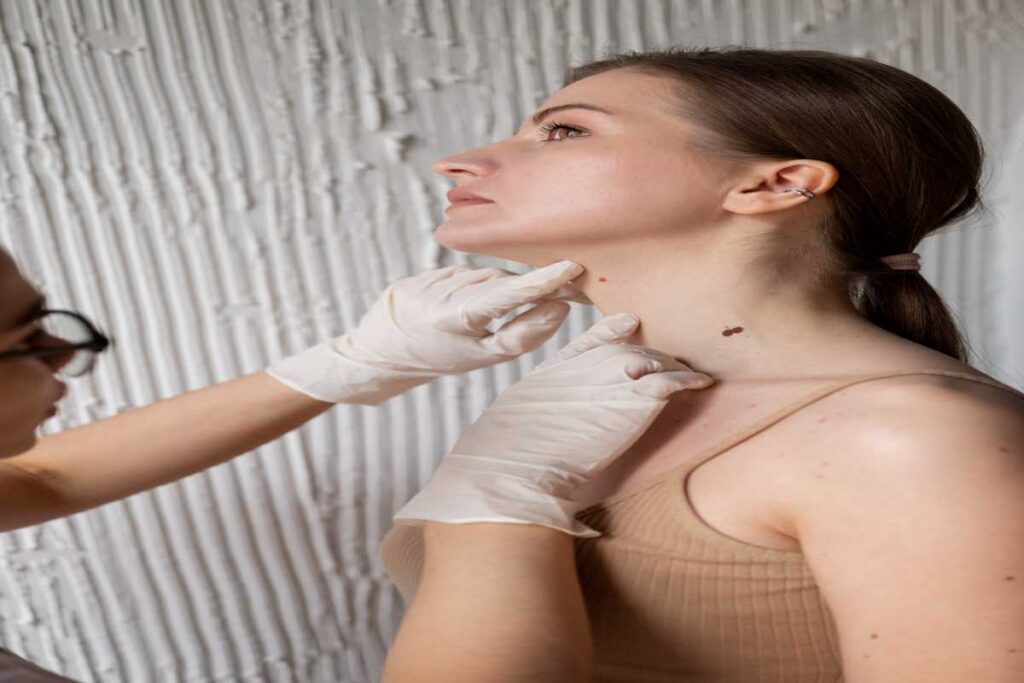Acne isn’t limited to the face. It can appear on various parts of the body, including the neck. Pimples on the neck can be uncomfortable, unsightly, and sometimes even painful. Neck acne is quite common and can affect people of all ages. Whether it’s from hormonal fluctuations, poor skincare habits, or environmental factors, dealing with neck acne can be frustrating.
Fortunately, there are several ways to address neck acne, both with home remedies and preventive measures. In this blog, we will explore the different types of neck acne, their causes, and provide effective home remedies to help you manage and prevent pimples on your neck.
Types of Neck Acne
Before delving into remedies, it’s important to understand the different types of neck acne. Acne on the neck can vary in severity and appearance, and knowing which type you have can help guide your treatment.
1. Whiteheads
Whiteheads are small, raised bumps that appear on the skin when hair follicles become clogged with excess oil, dead skin cells, and bacteria. Whiteheads on the neck can be quite noticeable and are often skin-colored or slightly white.
- Cause: Clogged pores, excessive oil production, and improper skincare.
- Appearance: Small, round, and flesh-colored with a white or yellowish center.
2. Blackheads
Blackheads are open comedones formed when pores are clogged with oil and dead skin cells. Unlike whiteheads, blackheads are open to the air, causing the trapped debris to oxidize and turn black.
- Cause: Accumulation of dirt, oil, and skin cells in open pores.
- Appearance: Small, black, or dark spots that are flat against the skin.
3. Cystic Acne
Cystic acne is one of the most severe types of acne, occurring when clogged pores get infected and form large, painful lumps under the skin. Cystic acne on the neck can be quite painful and may take longer to heal than other types of acne.
- Cause: Deep infection in hair follicles or sweat glands, often exacerbated by hormonal fluctuations or poor hygiene.
- Appearance: Large, red, swollen, painful lumps beneath the skin’s surface.
4. Papules
Papules are inflamed, red bumps that form when hair follicles become irritated but don’t contain pus. These bumps are often tender to the touch.
- Cause: Skin inflammation caused by blocked pores.
- Appearance: Small, raised, and red bumps, often accompanied by tenderness.
5. Pustules
Pustules are similar to papules, but unlike papules, they contain pus. These pimples can be painful and often have a white or yellow center.
- Cause: Infected pores, often with a buildup of oil, dead skin, and bacteria.
- Appearance: Red, swollen pimples with a white or yellow pus-filled center.

Causes of Neck Acne
Understanding the underlying causes of neck acne is crucial for managing and preventing it. Several factors contribute to the development of pimples on the neck:
- Hormonal Changes: Hormonal fluctuations, such as those during puberty, menstruation, or pregnancy, can increase oil production in the skin, leading to clogged pores and acne.
- Poor Hygiene: Not cleansing the neck area regularly or allowing sweat and dirt to accumulate on the skin can clog pores and contribute to acne.
- Tight Clothing or Accessories: Wearing tight collars, scarves, or necklaces can create friction and trap sweat, oil, and bacteria on the skin, causing breakouts.
- Hair Products: Some hair products, such as shampoos, conditioners, and styling gels, can leave residue on the skin, leading to clogged pores and neck acne.
- Diet: A diet high in processed foods, dairy, and sugar can contribute to acne flare-ups by increasing inflammation and oil production in the skin.
- Stress: High levels of stress can trigger hormonal changes, leading to breakouts on the neck and other areas of the body.
Home Remedies for Pimples on the Neck
While over-the-counter treatments are available, many people prefer natural home remedies for treating acne on the neck. Below are some effective and easy-to-implement home remedies that can help reduce neck pimples:
1. Tea Tree Oil
Tea tree oil has powerful antibacterial and anti-inflammatory properties, making it an excellent remedy for acne. It helps reduce the swelling and redness of pimples while fighting off the bacteria that cause acne.
- How to Use: Dilute a few drops of tea tree oil with a carrier oil, such as coconut or olive oil, and apply it to the affected area using a cotton swab. Leave it on for 15-20 minutes and rinse off with lukewarm water. Repeat this twice a day for best results.
2. Aloe Vera
Aloe vera is known for its soothing and healing properties, making it ideal for treating inflamed pimples on the neck. It can reduce redness, prevent infection, and promote faster healing.
- How to Use: Apply fresh aloe vera gel directly to the acne on your neck and leave it on for 20-30 minutes. Rinse off with water. Repeat daily for best results.
3. Apple Cider Vinegar
Apple cider vinegar contains acetic acid, which has antibacterial properties that can help kill acne-causing bacteria. It also helps balance the skin’s pH, which is important for preventing breakouts.
- How to Use: Dilute apple cider vinegar with water (1:3 ratio) and apply it to your neck using a cotton ball. Leave it on for a few minutes before rinsing with warm water. Use this remedy once a day.
4. Honey and Cinnamon Mask
Honey has antibacterial properties, while cinnamon helps improve blood circulation and reduce inflammation. Together, they make an effective remedy for treating pimples on the neck.
- How to Use: Mix 1 tablespoon of honey with 1 teaspoon of cinnamon powder to form a paste. Apply it to the affected areas and leave it on for 10-15 minutes. Rinse off with lukewarm water. Use this remedy 2-3 times a week.
5. Green Tea
Green tea is rich in antioxidants and has anti-inflammatory properties that can help reduce acne-causing bacteria and calm the skin. Drinking green tea and applying it topically can both be beneficial for neck acne.
- How to Use: Brew a cup of green tea and let it cool. Once cooled, soak a cotton ball in the tea and apply it to the acne-affected area. Leave it on for 10-15 minutes before rinsing off. Drink green tea regularly to reap its internal benefits as well.
6. Turmeric Paste
Turmeric has antibacterial and anti-inflammatory properties, making it a potent remedy for acne. It helps reduce swelling, redness, and pain associated with pimples.
- How to Use: Mix a small amount of turmeric powder with water or honey to form a paste. Apply it to the affected area and leave it on for 15-20 minutes before washing off with lukewarm water. Repeat 2-3 times a week.
7. Exfoliation with Baking Soda
Baking soda acts as a natural exfoliator that helps remove dead skin cells and unclog pores. It also has antibacterial properties, making it useful for treating acne.
- How to Use: Mix baking soda with water to form a paste. Gently massage the paste onto your neck in circular motions for about 1-2 minutes, then rinse with warm water. Use this remedy once or twice a week.
8. Lemon Juice
Lemon juice has natural astringent properties, which can help shrink pores and reduce acne. Its high vitamin C content also promotes skin healing.
- How to Use: Dab a small amount of lemon juice on the affected area using a cotton ball. Leave it on for 10-15 minutes before washing it off with water. Be cautious if you have sensitive skin, as lemon juice can sometimes cause irritation.
Preventive Measures for Neck Acne
In addition to home remedies, there are several preventive measures you can take to avoid neck acne in the future:
- Keep Your Neck Clean: Wash your neck daily to remove excess oil, dirt, and sweat. Use a gentle, non-comedogenic cleanser to avoid irritating the skin.
- Avoid Tight Collars: Tight clothing can create friction and trap sweat on the neck, leading to acne. Opt for looser-fitting shirts and scarves.
- Change Your Hair Care Products: If you notice neck acne, try switching to a more gentle, non-comedogenic shampoo or conditioner. Avoid letting your hair touch your neck if possible.
- Stay Hydrated: Drinking plenty of water helps keep your skin hydrated and flushes out toxins, which may contribute to acne.
- Avoid Touching Your Neck: Touching your neck with dirty hands can transfer bacteria and oils to your skin, leading to breakouts.
Conclusion: Managing and Preventing Neck Acne
Neck acne is a common concern, but with the right treatment and preventative measures, it can be managed effectively. By understanding the different types of neck acne and incorporating natural home remedies into your skincare routine, you can reduce the appearance of pimples and enjoy smoother, clearer skin. Consistency is key, so stick to a regular skincare regimen, and give these remedies time to work for you.

